Features
SIR PONNAMBALAM ARUNACHALAM (1853-1924)
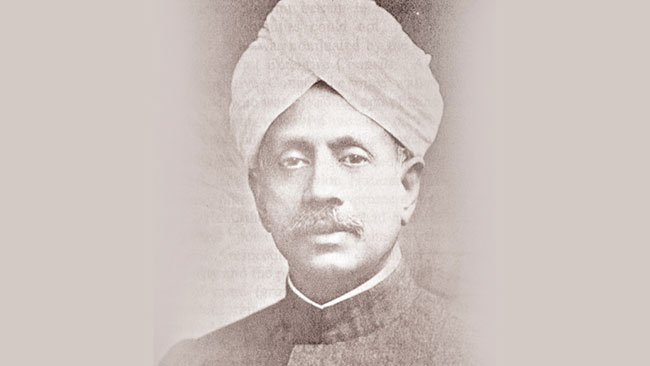
On the 98th Death Anniversary which falls on January 9, 2022 Compiled by Sega Nagendra and Suresh Murugaser, great grandchildren of Sir P. Arunachalam
FAMILY
Ponnambalam Arunachalam was the youngest Son of Gate Mudaliyar A. Ponnambalam.
He was born on September 14, 1853, to a highly respected and a well-educated professional family originally from Manipay, Jaffna.
Gate Mudaliyar Arumuganathapillai Coomaraswamy, his maternal grandfather, was the Tamil representative of the first Legislative Council established in 1834, following the recommendations of the Colebrooke-Cameron report of 1832. Colebrooke, coming from England, which was agitating for reform of the electoral system, was surprised at the autocratic powers exercised by the Governor of Ceylon since 1802. He effected a reduction of those powers by setting up an Executive and Legislative Council.
Sir Muttu Coomaraswamy, who was Arunachalam’s mother’s brother, had been a friend of Lord Houghton, Palmerston and Disraeli, in the London of the 1860’s. Sir Muttu was the first Ceylon Tamil (and probably, the first Asian) to receive a Knighthood, and the first non-Christian Asian to be called to the English Bar.
Sir Muttu’s only son, Dr. Ananda Coomaraswamy, world-famous art critic and author, who played a pivotal role in the cultural revival of India and Ceylon (including the proliferation of Buddhism in the latter), died in 1947 in Boston USA where he had worked in the Fine Arts Department for many years.
Both the elder brothers of Sir Ponnambalam Arunachalam were educated at the Colombo Academy (now Royal College), and then at Presidency College, Madras.
His eldest brother Ponnambalam Coomaraswamy had a distinguished career as a Proctor and was the Nominated Tamil Member of the Ceylon Legislative Counsel from 1893.
The next eldest child of the family, his brother, Ponnambalam Ramanathan, an Advocate, succeeded their uncle, Sir Muttu Coomaraswamy as the Nominated Tamil Representative, serving from 1879-1893, and later on from 1921 to 1924. Ponnambalam Ramanathan was also elected to the Legislature as Member for the Northern Province (Northern Division) seat, and occupied it from 1924 till his death in 1930. In addition to this appointment, Ramanathan was the island’s Solicitor-General from 1893-1906 for a period of 13 years, acted as Attorney-General on several occasions, and retired as a pensionable officer in 1906.
EDUCATION
Like his older brothers, Ponnambalam Arunachalam had his early education at the Colombo Academy, but, having won the English University Scholarship in 1870, he entered Christ College, Cambridge. He took with him a reputation as a student of exceptional merit, recommended by Sir Walter Sendall, Director of Public Instruction. At Cambridge, he proceeded to annex the Foundation Scholarship.
While at Cambridge, Arunachalam distinguished himself in both Classics and Mathematics. In the records of Christ College he is referred to as a “brilliant mathematician and an able classics scholar”.
As a student, Ponnambalam Arunachalam was in a position to watch the changes made by Disraeli to the voting system in Britain, and stored his observations for future reference.
Arunachalam had qualified for the Bar in England and was looking forward to a legal career, but on his return to Ceylon in 1875 his uncle Sir Muttu Coomaraswamy persuaded him to sit for the Civil Service examination. He did so, and his talent and academic excellence ensured that he was the first Ceylonese to enter the prestigious Civil Service through open competition.
GOVERNMENT CAREER
Arunachalam was not appointed to the Government Agent’s office in Colombo and then to a series of judicial posts in various parts of the island. This was a policy unofficially adopted by the British Government of the day, which effectively debarred outstanding Ceylonese from taking high office in Government and instead appointed them to various parts of the Island in different capacities, such as District Judges, Police Magistrates, and Commissioners of Requests.
When he was District Judge of Batticaloa and in the Fourth Class of the Civil Service, Sir Arthur Gordon appointed Arunachalam over the heads of about thirty seniors, among whom was Mr. (later Sir) Alexander Ashmore, to act in the office of the Registrar-General and Fiscal of the Western Province. A protest memorandum was lodged with the Secretary of State. But Sir Arthur Gordon, who obviously recognized merit when he found it, had his way and Arunachalam took office as Registrar-General.
Arunachalam now set himself to reform the Fiscal’s office which had become a den of corruption and inefficiency He reorganised the departments of Land Registration and Registration of Births, Deaths and Marriages, for which he was warmly congratulated by the Governor. The Times of Ceylon, reporting at the time Arunachalam entered the departments, on the Administration Reports on Land Registration and Vital Statistics, observed that they were places where chaos and corruption held merry sway. Fraud was rife. Dishonest deals often took precedence over genuine dealings, and everybody’s property and title were endangered.
The measure of the man may be seen in the way he set about reforming the Registrar-General’s Department. Sitting by the side of the various clerks as they performed their tasks, he patiently learned their work before launching the reforms by which he stopped the unconscionable delays and dishonesty prevailing in the registration of deeds, and ended the practice by which official work was being conducted as a form of private practice with fees levied privately for its discharge.
He started a real Record Room, supplied it with a system and an index, and founded a Benevolent Society which saved many a clerk from the grasp of money-lenders as well as from social disgrace and penury, paid many widows and orphans, and made clerical lives lighter and brighter. These activities were noticed by a distinguished American statistician, who informed the Governor of Ceylon that “there is not published in the entire United States a report equally valuable and comprehensive”.
Governor Sir West Ridgeway entrusted the organisation of the 1901 Census of Ceylon to Arunachalam. The report elicited the thanks of both the Governor and Secretary of State. But it was Armand de Souza, Editor of the Ceylon Morning Leader, an influential paper of the day, who wrote:
“The curious reader…. will find the Report which introduces the Census of 1901 perhaps the most luminous dissertation on the ethnological, social and economic conditions of the Island. In Sir P. Arunachalam’s Account of the history and religions of the Island in his Census Report would be found the language of Addison, the eloquence of Macaulay and the historical insight of Mommsen”.
In 1906 Arunachalam was appointed to the Legislative Council. In 1912 Governor Sir Henry McCallum nominated him to the Executive Council, as a personal appointment; and on his retirement from the Public Service in 1913, he was knighted in recognition of his distinguished service to the country.
POST-RETIREMENT
In 1913, a new phase in Arunachalam’s life began. In this year he joined a political movement demanding self-governance for the people of Ceylon. In an historic lecture entitled ‘’Our Political Needs”, given at the insistence of D.R.Wijewardene, Arunachalam crystallised the arguments for self-government.
In 1915 he was elected the first President of the Ceylon Social Service League for the upliftment of the poorer classes in Ceylon.
In 1917 he founded the Ceylon Reform League, and
In 1919 he delivered an address to a Sinhalese conference under the patronage of F.R.Senanayake, for the purpose of organising Peoples’ Associations throughout the Sinhalese districts of the Island for political, social and economic improvement. This movement directly gave birth to the Lanka Maha Jana Sabha.
HIS VISION
Arunachalam’s unstinted commitment to his dream of “Unity is Strength” illustrates the strong unity that existed at that time amongst the people of Ceylon, when Sinhalese, Tamils, Moors, Burghers were united in their approach to social reform. Unfortunately, the country now marches to a different drum resulting in mass exodus of many talented individuals and their progeny!
NATIONAL ORGANISATIONS
On December 11, 1919, the Ceylon National Congress was inaugurated, with the unanimous election of Arunachalam as its first President. It was he who advised various political organizations such as the Ceylon National Association, the Ceylon Reform League, the Chilaw Association, and the Jaffna Youth Association to unite into one body and lodge a joint appeal for political reform.
The Jaffna league joined the Ceylon National Congress on a condition: namely, that in a reformed Legislative Council there would be a special seat for the Tamils of the Western Province.
LEGISLATIVE COUNCIL
The reformed Legislative Council of 1921 did not have a seat for a Tamil.
The Low Country Association, with 11 voters elected Sir Henry De Mel in 1921, whilst the Town of Colombo with an electorate of 4,325, elected his Brother-in-Law, Sir James Peiris, unopposed. The vast number of people felt this to be the cause of Sir Ponnambalam’s untimely resignation from being the first President of the newly formed Ceylon National Congress (CNC), to form which he had exerted so much effort, persuasion and energy for quite some time. They all expected Sir Ponnambalam to be elected as the member for Colombo Town and Sir James Peiris who was a prominent member of the Low Country Products Association, to be elected by that body.
FATHER OF UNIVERSTY EDUCATION AND “SWABASHA”
Sir Ponnambalam Arunachalam’s contribution to the field of education was that of a pioneer. In his notes to the Director of Public Instruction, he stated that the fundamental defect in the system of elementary education in Ceylon was that English was employed as the medium of instruction.
In a real sense, as has been pointed out, he was the father of the concept of ‘Swabasha’. Unfortunately, this idea was worked upon by later politicians who mis-read it, totally rejecting English, which could have been the link language unifying the different ethnic groups of Ceylon. Since at that time the people of Ceylon were still functioning as a united family, the need for a link language did not assert itself. The paths of History are littered with missed opportunities, and sadly, this was one of them.
Sir Ponnambalam Arunachalam has been rightly called the Father of the Ceylon University Movement as he was responsible for the Ceylon University Association which was formed in January 1906. In his memorandum to the Governor, Sir West Ridgeway, requesting the Government to appoint a Commission to report on educational progress and needs, Arunachalam appealed to the Government to create a “Ceylon University”; or at least to raise Royal College to the status of a University College, which would be of lasting benefit to the people and a fitting monument to His Excellency’s rule in Ceylon. He suggested that Ceylon and Indian History and Geography could replace English History and Geography on the curriculum of such an institution. “His Excellency on 15 October decided to take no action” was the negative response he received from the Governor’s Secretary.
ACHIEVEMENTS IN A NUTSHELL
Looking back on Sir Ponnambalam Arunachalam’s career, we contemplate a life studded with immense contributions in a range of different fields of endeavour. Those contributions by which he will always be remembered include
His membership and Presidency of the Royal Asiatic Society
His role as Founder President of the Ceylon Saiva Paripalana Sabhai (a religious organisation which encourages the practice of Hinduism)
The re-organisation of the Registrar-General’s Department (a Herculean task, magnificently performed)
The formation of the Ceylon National Congress, whose real potential for national unity was destroyed by the petty self-interest of some influential sections of the Sinhalese
His original and outstanding contribution to the establishment of the Ceylon University College.
The steadfast belief in the unity of his country’s various communities in a single sovereign state, which he carried with him throughout his life.
THE FINALE
By then, Sir Ponnambalam was an exhausted and tired genius, perhaps disillusioned, yet one who understood human nature and became more forgiving and gracious. Towards the end of 1923, he undertook a pilgrimage to visit the Sacred Shrines in India. In the midst of his devotions at Madurai in South India, he passed away on January 9, 1924, leaving behind him memories of a noble life well spent in the service of his Country and his people.
THE TRIBUTES
The day after his death, the “Ceylon Daily News” described him in an Editorial as ‘’the most powerful personality in Ceylon’’ and the “Times of London” described him as ‘’Founder of modern Ceylon’’.
When Professor Marrs, the first Principal of the University College, heard of Arunachalam’s death at Madurai on January 9, 1924, while on a pilgrimage worshipping at the Hindu temples in South India, he summoned the students of the University College to the main hall and addressed them in these words:
“Gentlemen, I have asked you to assemble here at this hour as a mark of respect to the memory of one who was in a very real sense the Father of the University project in Ceylon. Little or nothing has been said of that side of his activities which to those who were in close touch with him was the inspiration of his latter days – the side which concerns you and me as members of an institution so dear to his heart, the Ceylon University College Sir Ponnambalam Arunachalam presided over the Public Meeting which was called to consider the question of the establishment of a University in Ceylon on January 19, 1906. From that day to the day of his decease Sir Ponnambalam Arunachalam has pursued his object to use his own words, “without let or restraint”, undeterred by the doubts of men without vision or the delay to which an untried project must, I suppose, always be subjected by conservers of tradition”.
Sir Ponnambalam Arunachalam has been honoured by the erection of his statue in Parliament Square in 1930, and by the unveiling of his portraits at Royal College and at the Offices of both the Ceylon National Congress and the Ceylon Social Service League. His name graces Arunachalam Hall, the first Hall of Residence to be opened to students at the University of Peradeniya in 1951, and a commemorative one-rupee postage stamp was issued in his memory on March 10, 1977. His philosophical and religious contributions were collected and published in 1937, with the title “Studies and Translations”.
In his ‘’Message to the Country’’ published by his good friend D.R. Wijewardene (who had returned from Cambridge with a degree in Law and as a Barrister, and persuaded Sir Ponnambalam Arunachalam to resume his political activities) in the very first issue of the ‘’Ceylon Daily News’’ of January 3, 1918, he declared :
‘’ In our zeal for political reform we must be on our guard against making it an end. We seek it not to win rights but to fulfil duties to ourselves and our Country. People have a distinct task to perform. Our youth will seek their own well-being. They will work in unity so that all the intellectual forces defused among men may obtain the highest development in thought and action. With our youth inspired by such ideas, I would like to see our Country rise with renewed splendour to be a beacon light to all lands. ‘’
The next substantial reference to him was by the late, great Mr. D.R. Wijewardene himself, who was his great friend and admirer. On the occasion of Ceylon’s independence, he rose from his sick bed, whilst in retirement in 1948, and in ‘’Ceylon Daily News’’ reflecting on events over 32 years earlier, he wrote: – ‘’ In those days, the national consciousness was dormant and there was nothing in the spirit of the times to stir it to life and activity. Later, largely as a result of Sir Ponnambalam Arunachalam’s work, the fire of the national soul was quickened. When he delivered his epoch-making address on April 2, 1917 on ‘’Our Political Needs’’ at the Masonic Hall, that leader of imperishable memory set in motion influences that were to change the history of this Country. It was both a starting point and a blue-print for the important Constitutional changes that followed.
The immediate outcome of that meeting was the formation of the Ceylon National Congress. It was then that the national movement which has brought Ceylon to the threshold of Independence received its stimulus. Public opinion began to speak for the first time with a firm tone’’.
Sir Ponnambalam Arunachalam stands out as an outstanding leader of honesty, integrity and achievement, and is a beacon to us all.
Most of us would have been satisfied by association with one or other of such monumental endeavours. But Sir Ponnambalam Arunachalam seems to have been a human dynamo – a true nationalist and patriot of Ceylon.
A short time after Sir Ponnambalam Arunachalam’s death, grateful people honoured his memory by erecting his statute in the grounds of Parliament House. It was unveiled by the Governor, Sir Herbert Stanley on April 3, 1930. It was the first statute to adorn these premises, and stood in solitary splendour till the statute of his brother Ramanathan was erected in 1953. The inscription of the statute reads as follows:
SIR PONNAMBALAM ARUNACHALAM
1853 -1924
Scholar, Statesman, Administrator, Patriot
Erected by a Grateful People in
Testimony of a life nobly spent
In the service of his country and
Signal services as the champion of
A reformed legislature and of
His matchless devotion and
Steadfastness in the cause
Of the Ceylon University
Features
Evolution of Paediatric Medicine in Sri Lanka: Honouring Professor Herbert Aponso on his 100th Birthday.
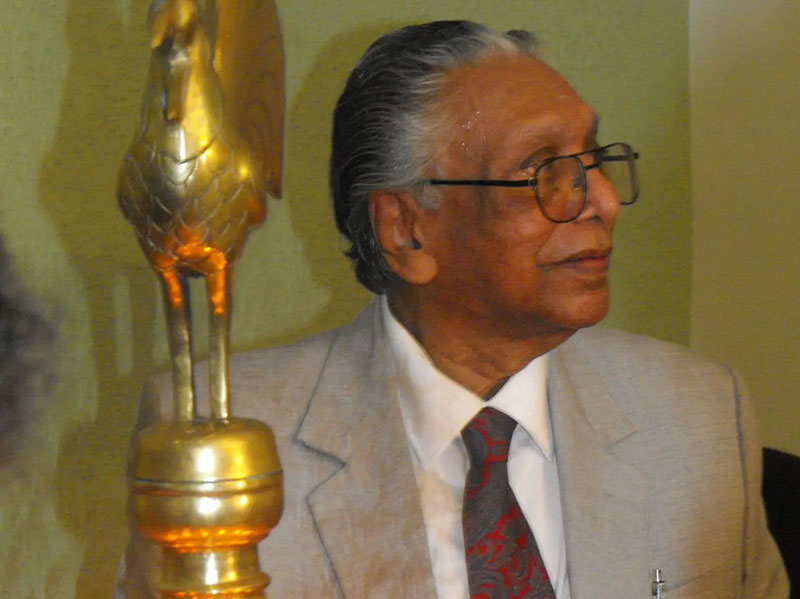
Professor Herbert Allan Aponso, born on March 25, 1925, recently celebrated his 100th birthday at his serene home in Kandy. Surrounded by his cherished children, the occasion not only honoured his extraordinary life but also served as a tribute from his academic colleagues, recognising his outstanding contributions to the field of paediatrics in Sri Lanka. Professor Aponso is widely recognised for his exceptional ability to combine extensive field experience with academic teaching and groundbreaking research. He emphasised social causes of disease and maintained that a disease is not just a manifestation of biological factors in the human body, but an expression of social and environmental factors as well. He encouraged his students to consider social aspects, such as family factors and poverty, in order to explain diseases, particularly childhood diseases such as malnutrition.
Born in Lakshapathiya, Moratuwa, Aponso began his academic journey at Prince of Wales College, Moratuwa, excelling in the Senior School Certificate and London Matriculation Examinations. His medical aspirations led him to the University of Colombo in 1943 and subsequently to the Medical College, where he graduated MBBS with honours in 1949. Pursuing further specialisation, he trained in paediatrics at the prestigious Great Ormond Street Hospital for Children, the largest and oldest children’s hospital in the UK, earning his DCH (London) in 1956 and MRCP (Edinburgh) in 1957.
Upon his return to Ceylon in 1958, Aponso earned his MD in Medicine and commenced a distinguished academic career. He joined the Faculty of Medicine in Colombo as a Senior Lecturer in 1963 and subsequently took on the role of Lecturer-in-Charge of Paediatrics at the University of Ceylon in Peradeniya in 1964. His career saw steady progression as he was promoted to Associate Professor in 1974 and ultimately attained the position of full Professor of Paediatrics in 1977.
Aponso was a Fellow of both the Royal College of Physicians (Edinburgh) and the Ceylon College of Physicians. He actively contributed to the Kandy Society of Medicine, where he served as President from 1974 to 1975. Beyond medicine, he played key roles in community organisations. Before relocating to Kandy, he was the president of the Moratuwa YMCA and a founding member of the Moratuwa Y’s Men Club. Later, he led the Kandy Y’s Men’s Club, which evolved into the Mahanuwara Y’s Men’s Club.
His contributions extended into promoting nutritional advancements, notably advocating for the consumption of soya. He pioneered the preparation of soya products in the kitchen of the Peradeniya Teaching Hospital and established a Soya Centre linked to the Kandy YMCA. Further showcasing his dedication to public health, he presided over the Sri Lanka Association for Voluntary Surgical Contraception and Family Health during two separate periods: 1977–1979 and 1986–1987. Additionally, he led the Sri Lanka Paediatric Association from 1976–1977.
Even after retiring from the University of Peradeniya in 1993, his impact endured. In recognition of his lifelong contributions, the university awarded him an honorary DSc in 2022. Through his tireless dedication, Professor Aponso profoundly influenced paediatric medicine in Sri Lanka, leaving an enduring legacy in both academic and medical spheres. Paediatrics as a specialised field of medicine in Sri Lanka has evolved over centuries, shaped by indigenous healing traditions, colonial medical advancements, and modern institutional developments. During colonial times under the Portuguese and Dutch, children continued to be treated through traditional medicine. The British colonial administration formalised Western medical education and established hospitals. In 1870, the Ceylon Medical College (now the Faculty of Medicine, University of Colombo) was founded, producing doctors trained in Western medicine. Paediatric care as a distinct discipline began to emerge in the early 20th century, having previously been part of general medicine. The introduction of vaccination programmes, particularly against smallpox, was a major public health advance introduced under the Vaccination Ordinance of 1886. It was during the1920s that Maternal and Child Health Clinics were setup in villages, laying the foundations for addressing child health issues in the country.
The early decades of the century saw the establishment of paediatric units in major hospitals, a critical step towards recognising and addressing the distinct medical needs of children. The establishment of paediatric units in major hospitals in Sri Lanka began in the mid-20th century, with significant developments occurring in the 1950s and 1960s. These units were set up to provide specialised care for children, addressing their unique medical needs. For example, the Lady Ridgeway Hospital for Children in Colombo became a national tertiary care centre, offering advanced paediatric services Hospitals such as the Colombo General Hospital (now the National Hospital of Sri Lanka) and played a pioneering role in creating specialised wards dedicated to paediatric care, laying the foundations for future advancements in the field.
A major turning point in the progress of paediatrics in Sri Lanka came with the appointment of Dr. C. C. de Silva as the first Professor of Paediatrics at the University of Ceylon (now the University of Colombo) in the 1950s. He was instrumental in formalising paediatric education and training, ensuring that future medical professionals were equipped with the knowledge and skills to provide specialised care for children. The introduction of dedicated paediatric courses in medical schools marked a shift from traditional general practice to a more specialised approach to child healthcare. The 1950s also saw the expansion of paediatric services beyond Colombo, with provincial hospitals establishing their own paediatric units, making specialised care accessible to a wider population.
The latter half of the 20th century witnessed remarkable progress in paediatric care, with the establishment of postgraduate training programmes aimed at producing highly qualified paediatricians. These programmes were designed to meet the increasing demand for specialised medical professionals who could address the complex healthcare needs of children. Alongside these educational advancements, there was a significant improvement in neonatal and maternal healthcare services, leading to better survival rates for newborns and reducing infant mortality. Innovations in paediatric research and healthcare policies further contributed to improvements in the overall well-being of children in Sri Lanka.
By the 1980s, paediatrics had firmly established itself as a distinct and essential medical discipline in Sri Lanka. The introduction of specialised paediatric subfields such as neonatology, cardiology, and nephrology allowed for more targeted treatment and improved health outcomes for children with complex medical conditions. The role of paediatricians expanded beyond hospital care, with increased involvement in public health initiatives such as immunisation programmes and nutritional interventions. The collaborative efforts of the government, medical institutions, and healthcare professionals ensured that paediatric care in Sri Lanka continued to progress in parallel with global medical advancements.
The development of paediatric specialization in Sri Lanka during the 20th century was a transformative journey that laid the groundwork for the country’s modern child healthcare system. From its humble beginnings in general hospital wards to the establishment of specialised training programmes and research initiatives, paediatrics evolved into a well-defined and essential medical discipline. This progress not only improved healthcare outcomes for children but also contributed to the overall strengthening of the medical field in Sri Lanka. Today, paediatrics continues to be a vital component of the healthcare system, building upon the foundations set during the 20th century to ensure a healthier future for the nation’s children. Professor Aponso was integral to the shaping of this process of development, in the 1950s and afterwards, fully engaged in every aspect. His involvement was not just academic, as he was an advisor to the government and other organisations, such as the World Health Organization, on matters about advancements in child health.
One of his most significant accomplishments was a six-year research project, generously funded by the World Health Organization (WHO) and the Canadian International Development Agency (CIDA). This initiative was integral to addressing pressing health challenges within the Mahaweli Accelerated Development Programme in its initial phase. The project focused particularly on improving healthcare services in System ‘C’ of Girandurukotte, a region populated by settlers relocated from villages inundated due to the construction of large tanks and reservoirs. The programme was launched shortly after the settlers arrived, aiming to tackle the myriad health issues they encountered as newcomers to the dry zone settlements.
Under Aponso’s leadership, ‘mothers’ clubs’ were established in hamlets in each of the four settlement units chosen for intervention. These clubs became vital community spaces where families could engage in discussions about the health problems they faced. The challenges were numerous and varied, including skin diseases, issues with drinking water, snake bites, elephant attacks, and accidents sustained while working in newly cleared paddy lands. Malaria and flu posed an especially serious threat at the time, necessitating timely treatment.
The mothers’ clubs operated as dynamic forums where settlers could participate in question-and-answer sessions about their health concerns. These sessions often culminated in providing treatments for those afflicted. The efforts were supported by Dr. (Mrs.) Fernando, a dedicated health officer in ‘System C’ of Girandurukotte, who attended most of the meetings, ensuring professional medical assistance. Professor Aponso was also assisted by lecturers at the Department of Paediatrics and a health education officer, Mrs. Alagoda, whose skills in engaging with mothers played a pivotal role in the success of the discussions and outreach programmes.
During this period, the Centre for Intersectoral Community Health Studies (CICHS) emerged under the visionary leadership of Professor Aponso. As an interdisciplinary scholarly organisation dedicated to advancing health research in Sri Lanka, CICHS made remarkable strides in the field. Among its pioneering initiatives, the sexual-risk prevention programme stood out as a milestone. This programme prioritised fostering individual competencies while shaping cultural norms that encourage healthy sexual decision-making, reflecting the organisation’s commitment to impactful research and community well-being.
As the project manager of the WHO/CIDA project, I had the privilege of working closely with Professor Aponso. I travelled frequently from my office at the Department of Paediatrics at Peradeniya to the villages, coordinating the programme’s activities. We collected household data on a sample within selected settlement units, such as Teldeniyaya, Hombariyawa, Millaththewa and Rambewa. To make a comparison, we also collected data from Mawanella rural villages, which was considered the control area. This information was then meticulously analysed using an IBM computer, a remarkable technological feat at a time when computers were a rarity.
Our research team, comprising approximately ten recent sociology graduates, including KMHB Kulasekera, RM Karunasekara and Nandani de Silva, worked tirelessly to collect, compile and interpret the data. The findings were shared at various conferences in the form of scholarly articles, providing valuable contributions to both national and global conversations on the public health challenges faced by communities in transition.
Professor Aponso’s work not only made a profound impact on the lives of those settlers but also left an indelible mark on the field of social paediatrics, demonstrating the transformative power of community-based health initiatives supported by collaborative research.
Aponso’s contributions to child healthcare, particularly in the areas of neonatology, nutrition, and medical education are important. As a student of Dr. C. C. de Silva, he was deeply influenced by his mentor’s pioneering work in paediatrics and carried forward his legacy by further strengthening child healthcare services in Sri Lanka. Dr. L.O. Abeyratne was the first Professor of Paediatrics at Peradeniya, and, upon his retirement, Professor Aponso succeeded him, continuing to advance paediatric education and healthcare in Sri Lanka. Aponso was particularly known for his work in neonatal care and the prevention of childhood malnutrition. He played a key role in introducing and promoting best practice in newborn care, helping to reduce infant mortality rates in Sri Lanka. His advocacy for improved maternal and child health policies contributed to the expansion of paediatric services beyond Colombo, ensuring that specialized care was accessible to children in rural areas as well.
Beyond clinical practice, Professor Aponso was a dedicated medical educator. He trained and mentored numerous paediatricians, helping to shape the next generation of child healthcare professionals in Sri Lanka. His work in medical research and teaching influenced advancements in paediatric care and was
instrumental in establishing higher standards in paediatric training programmes. In 2011, in commemoration of his work, Dr. Ananda Jayasinghe edited a collection of essays titled ‘In honour of Herbert Allan Aponso, emeritus professor of paediatrics, University of Peradeniya, Sri Lanka.’
Professor Aponso is a remarkable individual whose humility is as profound as his ability to listen with intention and honour to the perspectives of those around him. A celebrated expert in his field, he was elected President of the Sri Lanka Paediatric Association in 1976 and ascended to the role of full Professor of Paediatrics in 1977. His dedication extended far beyond academia—he served as President of the Young Men’s Christian Association in Kandy during three pivotal periods: 1966–1968, 1973–1975, and 1984–1988.
In 1952, he embarked on a lifelong partnership with Jayanthi Vimala Dias, now deceased, building not just a family but a legacy of intellect and social impact. Together, they raised three children—Ajith, Heshan, and Charmalie—who each distinguished themselves in society. Their home became a vibrant epicentre of stimulating dialogue and collaborative ideas, welcoming friends to partake in lively, thought-provoking discussions.
For me, the memory of Professor Aponso is forever intertwined with the dynamic days of the Mahaweli research project and CICHS initiatives, where his presence enriched every endeavour. As he continues his retirement journey, I wish him abundant health and days brimming with vitality, joy, and a renewed sense of purpose.
by M. W. Amarasiri de Silva
(Emeritus Professor of Sociology, University of Peradeniya Sri Lanka and Lecturer at the University of California, Santa Cruz, USA).
Features
Indian colonialism in Sri Lanka

Following independence from Britain, both India and Sri Lanka emerged as leaders of the Non-Aligned Movement, which sought to advance developing nations’ interests during the Cold War. Indeed, the term “non-alignment” was itself coined by Indian Prime Minister Jawaharlal Nehru during his 1954 speech in Colombo. The five principles of the Non-Aligned Movement are: “mutual respect for each other’s territorial integrity and sovereignty; mutual non-aggression; mutual non-interference in domestic affairs; equality and mutual benefit; and peaceful co-existence.”
Later, Indian Prime Minister Indira Gandhi played a key role in supporting Sri Lankan Prime Minister Sirimavo Bandaranaike’s 1971 proposal to declare the Indian Ocean a Zone of Peace at the United Nations.
Such progressive ideals are in stark contrast to the current neocolonial negotiations between the two countries.
Indian Prime Minister Narendra Modi’s forthcoming visit to Sri Lanka on April 4, 2025, is presented as representing a mutually beneficial partnership that will bring economic development to debt-burdened Sri Lanka. However, the details of the strategic agreements to be signed during Modi’s visit remain undisclosed to the public. This opacity cannot be a good sign and should not be accepted uncritically by the media or the people of either nation.
The Indo-Lanka Agreement of July 29, 1987, was also crafted without consultation with the Sri Lankan people or its parliament. It was signed during a 48-hour curfew when former Indian Prime Minister Rajiv Gandhi arrived in Sri Lanka. This agreement led to the imposition of the 13th Amendment to the Sri Lankan Constitution and established the Provincial Council system. The political framework it created continues to challenge Sri Lanka’s territorial integrity and sovereignty. Rather than bringing peace, India’s 1987 intervention resulted in one of the most violent and chaotic periods in the island’s recent history.
Will these agreements being finalised with Prime Minister Modi also lead to a period of pillage and plunder of the island’s resources and worsening conditions for its people, rather than delivering the promised economic benefits? It is crucial that any bilateral agreements include enforceable measures to stop Indian bottom trawlers from illegally fishing in Sri Lankan territorial waters. This decades-long practice has caused severe damage to Sri Lanka’s marine resources and inflicted significant economic losses on its fishing communities.
Facing an increasing Chinese presence in Sri Lanka and the Indian Ocean, India has sought to strengthen its political, economic, strategic and cultural influence over Sri Lanka through various overt and covert means. During Sri Lanka’s 2022 economic crisis, for example, India provided $4 billion in financial assistance through currency swaps, credit lines, and loan deferrals that enabled Sri Lanka to import essential goods from India. While this aid has helped Sri Lanka, it has also served India’s interests by countering China’s influence and protecting Indian business in Sri Lanka.
Prime Minister Modi’s upcoming visit represents the culmination of years of Indian initiatives in Sri Lanka spanning maritime security, aviation, energy, power generation, trade, finance, and cultural exchanges. For example, India’s Unified Payment Interface (UPI) for digital payments was introduced in Sri Lanka in February 2024, and in October 2023 India provided funds to develop a digital national identity card for Sri Lanka raising concerns about India’s access to Sri Lanka’s national biometric identification data. Indian investors have been given preferential access in the privatisation of Sri Lanka’s state-owned enterprises (SOEs) in key sectors like telecommunications, financial services, and energy. Adani Group’s West Terminal project in Colombo Port is explicitly designed to counter China’s control over Sri Lanka’s port infrastructure, including the Colombo International Container Terminal, Hambantota Port, and Port City Colombo.
India and Sri Lanka have recently agreed to resume negotiations on the Economic and Technology Cooperation Agreement (ETCA), which focuses primarily on the service sector and aims to create a unified labour market. However, Sri Lankan professional associations have raised concerns that ETCA could give unemployed and lower-paid Indian workers a competitive advantage over their Sri Lankan counterparts. These concerns must be properly addressed before any agreement is finalised.
On December 16, 2024, India and Sri Lanka signed several Memoranda of Understanding (MOUs) in New Delhi to enhance cooperation in defense, energy, and infrastructure development. These include plans for electricity grid interconnection and a multi-product petroleum pipeline between the two countries. Building on these agreements, construction of the Sampur power plant in Trincomalee is expected to begin during Prime Minister Modi’s April visit.
The Sampur power plant project, combined with India’s takeover of the Trincomalee Oil Tank Farm, represents a significant step toward integrating Sri Lanka into India’s national energy grid. This development effectively brings Trincomalee’s strategic natural harbour – often called the “crown jewel” of Sri Lanka’s assets – under Indian control, transforming it into a regional energy hub. In 1987, during India’s military intervention in Sri Lanka, New Delhi pressured Colombo into signing a secret agreement stipulating that the British-era Trincomalee oil tank farm would be jointly developed with India and could not be used by any other country.
While India promotes its energy interconnection projects as enhancing regional energy security, recent experiences in Nepal demonstrate how electricity grid integration with India has made Nepal dependent on and subordinate to India for its basic energy needs. Similarly, Bangladesh’s electricity agreement with the Adani Group has created an imbalanced situation favouring Adani over Bangladeshi power consumers. What collective actions could Sri Lanka and other small nations take to avoid such unequal “energy colonialism” and protect their national security and sovereignty?
India’s emergence as a superpower and its expansionist policies are gradually transforming neighbouring South Asian and Indian Ocean states into economically and politically subordinate entities. Both Sri Lanka and the Maldives have adopted “India First” foreign policies in recent years, with the Maldives abandoning its “India Out” campaign in October 2024 in exchange for Indian economic assistance.
India’s “Neighbourhood First Policy” has led to deep involvement in the internal affairs of neighbouring countries including Sri Lanka. This involvement often takes the form of manipulating political parties, exploiting ethnic and religious divisions, and engineering political instability and regime changes – tactics reminiscent of colonial practices. It is well documented that India provided training to the LTTE and other terrorist groups opposing the Sri Lankan government during the civil war.
Contemporary Indian expansionism must be viewed within the broader context of the New Cold War and intensifying geopolitical competition between the United States and China. Given its strategic location along the vital east-west shipping routes in the Indian Ocean, Sri Lanka has become a pawn in this great power rivalry. In addition to granting China extensive control over key infrastructure, Sri Lanka has signed the Acquisition and Cross-Servicing Agreement (ACSA) and Status of Forces Agreement (SOFA) with the United States, effectively allowing the use of Sri Lanka as a U.S. military logistics hub. It was reported that during a visit to Sri Lanka in February 2023, Victoria Nuland, former Under Secretary of State for Political Affairs of the United States strongly suggested the establishment of a joint US-Indian military base in Trincomalee to counter Chinese activities in the region.
As a member of the Quadrilateral Security Dialogue (QUAD) – a strategic alliance against Chinese expansion that includes the United States, Australia and Japan – India participates in extensive QUAD military exercises like the Malabar exercises in the Indian Ocean. However, India’s role in QUAD appears inconsistent with its position as a founding member of BRICS (Brazil, Russia, India, China, South Africa), which was established to promote the interests of emerging economies and a multipolar world order. Unfortunately, BRICS appears to be replicating the same patterns of domination and subordination in its relations with smaller nations like Sri Lanka that characterise traditional imperial powers.
India presents itself as the guardian of Buddhism, particularly in its relations with Sri Lanka, to foster a sense of shared cultural heritage. However, it was Sri Lanka – not India – that preserved the Buddha’s teachings as they declined and eventually disappeared from India. Sri Lanka maintained the Buddhist tradition despite seventeen major invasions from India aimed at destroying the island’s Buddhist civilization.
Even today, despite its extensive influence, India has not taken meaningful steps to protect Buddhist temples and archaeological sites in Sri Lanka’s north and east from attacks by Tamil separatist groups. Instead, India appears focused on advancing the concept of Akhand Bharat (Undivided India) and Hindu Rashtra (Hindu Nation), which seeks to incorporate neighboring countries like Sri Lanka into a “Greater India.” The promotion of the bogus Ramayana Trail in Sri Lanka and the accompanying Hinduization pose a serious threat to preserving Sri Lanka’s distinct Buddhist identity and heritage.
Indian neocolonialism in Sri Lanka reflects a global phenomenon where powerful nations and their local collaborators – including political, economic, academic, media and NGO elites – prioritize short-term profits and self-interest over national and collective welfare, leading to environmental destruction and cultural erosion. Breaking free from this exploitative world order requires fundamentally reimagining global economic and social systems to uphold harmony and equality.
In this global transformation, India has a significant role to play. As a nation that endured centuries of Western imperial domination, India’s historical mission should be to continue to lead the struggle for decolonization and non-alignment, rather than serving as a junior partner in superpower rivalries. Under Mahatma Gandhi’s leadership, India championed the worldwide movement for decolonization and independence in the modern era.
Upholding the principles of the Non-Aligned Movement could forge a partnership benefiting both nations while preserving Sri Lanka’s independence and Buddhist identity. Otherwise, the New Cold War will continue to trample local sovereignty, where foreign powers vie to exploit the island’s resources, subjugate local communities and accelerate environmental and cultural destruction.
by Dr. Asoka Bandarage
Features
Batalanda Skeletons, Victims’ Sorrows and NPP’s Tasks
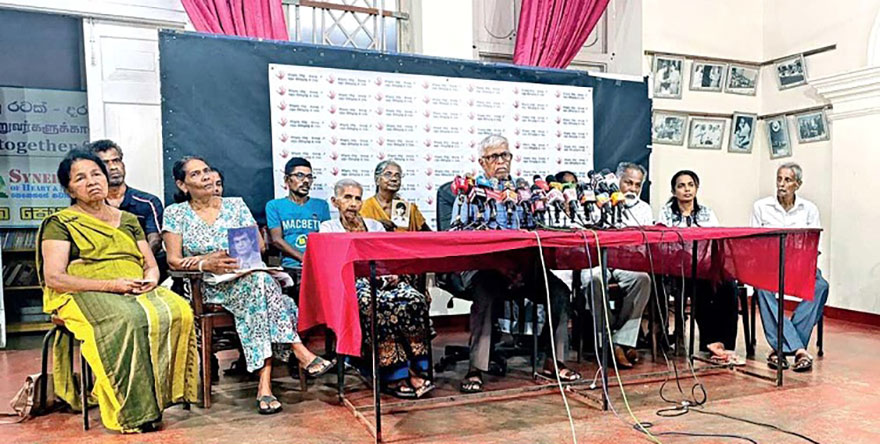
Few foresaw skeletons of Batalanda come crashing down in a London television interview. There have been plenty of speculations about the intended purposes and commentaries on the unintended outcomes of Ranil Wickremesinghe’s Al Jazeera interview. The more prurient takes on the interview have been about the public dressing down of the former president by the pugnacious interviewer Mehdi Hasan. Only one person seems convinced that Mr. Wickremesinghe had the better of the exchanges. That person is Ranil Wickremesinghe himself. That is also because he listens only to himself, and he keeps himself surrounded by sidekicks who only listen and serve. But there is more to the outcome of the interview than the ignominy that befell Ranil Wickremesinghe.
Political commentaries have alluded to hidden hands and agendas apparently looking to reset the allegations of war crimes and human rights violations so as to engage the new NPP government in ways that would differentiate it from its predecessors and facilitate a more positive and conclusive government response than there has been so far. Between the ‘end of the war’ in 2009, and the election of President Anura Kumara Dissanayake and the NPP government in 2024, there have been four presidents – Mahinda Rajapaksa, Maithripala Sirisena, Gotabaya Rajapaksa and Ranil Wickremesinghe – and as many governments. Of the four, Ranil Wickremesinghe is the least associated with the final stages of the war and its ending. In fact, he was most associated with a failed, even flawed peace process that ultimately ensured the resumption of the war with vengeance on both sides. RW was also the most receptive to war crimes investigations even proffering that external oversight would not be a violation of Sri Lanka’s Constitution.
One school of thought about the Al Jazeera interview is that those who arranged it were hoping for Ranil Wickremesinghe to reboot the now stalling war crimes project and bring pressure on the NPP government to show renewed commitment to it. From the looks of it, the arrangers gave no thought to Ranil Wickremesinghe’s twin vulnerabilities – on the old Batalanda skeletons and the more recent Easter Sunday bombings. If Easter Sunday was a case of criminal negligence, Batalanda is the site of criminal culpability. In the end, rather than rebooting the Geneva project, the interview resurrected the Batalanda crimes and its memories.
The aftermath commentaries have ranged between warning the NPP government that revisiting Batalanda might implicate the government for the JVP’s acts of violence at that time, on the one hand, and the futility of trying to hold anyone from the then government accountable for the torture atrocities that went on in Batalanda, including Ranil Wickremesinghe. What is missing and overlooked in all this is the cry of the victims of Batalanda and their surviving families who have been carrying the burden of their memories for 37 years, and carrying as well, for the last 25 years, the unfulfilled promises of the Commission that inquired into and reported on Batalanda.
The families impacted by Batalanda gave a moving illustration of the agony they have been going through for all these years in a recent media briefing, in Colombo, organized by the indefatigable human rights activist Brito Fernando. I am going by the extensive feature coverage of the media event and the background to Batalanda written by Kamanthi Wickremesinghe in the Daily Mirror (March 20, 2025). I am also borrowing her graphics for illustration – a photograph of the media briefing and a map of Sri Lanka showing the scattered sites of mass graves – 20 in all.
“We express gratitude to this government for providing the environment to discuss and debate about the contents of this report,” said Brito Fernando, speaking for the families. After addressing Ranil Wickremesinghe’s obfuscations about his involvement, and decrying Chandrika Kumaratunga’s failure to act on the recommendations of the report of the Batalanda Commission of Inquiry she created, Mr. Fernando appealed to the present NPP government to “provide a secure environment where these victims could come out and speak about their experiences,” Nothing more, nothing less, and that is all there is to it.
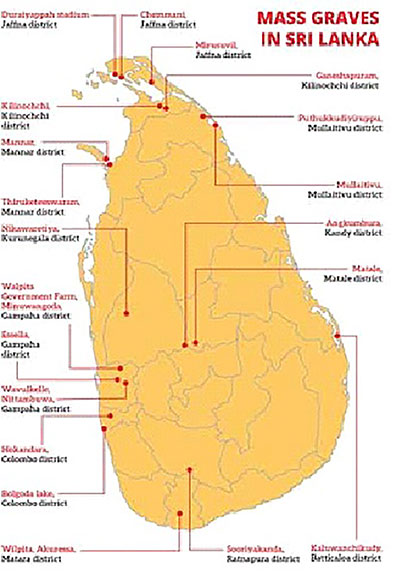 Whatever anyone else might say, the victims of Batalanda and their survivors have vindicated the NPP government’s decision to formally table the Batalanda Commission Report in parliament. As for their continuing expectations, Brito Fernando went on say, “We have some hopes regarding this government, but they should walk the talk.” Mr. Fernando suggested that the government should co-ordinate with the UNHRC’s Sri Lanka Accountability Project that has become a valuable resource for preserving evidence and documentation involving human rights crimes and violations over many decades. In addition, Mr. Fernando pointed out that the grieving families have not been involved in the ongoing excavations of mass graves, and they are anxious to receive the remains of their dear ones after their identity is confirmed through DNA analyses. Nor has there been any sign of legal action being taken against any of the suspects connected to the mass graves.
Whatever anyone else might say, the victims of Batalanda and their survivors have vindicated the NPP government’s decision to formally table the Batalanda Commission Report in parliament. As for their continuing expectations, Brito Fernando went on say, “We have some hopes regarding this government, but they should walk the talk.” Mr. Fernando suggested that the government should co-ordinate with the UNHRC’s Sri Lanka Accountability Project that has become a valuable resource for preserving evidence and documentation involving human rights crimes and violations over many decades. In addition, Mr. Fernando pointed out that the grieving families have not been involved in the ongoing excavations of mass graves, and they are anxious to receive the remains of their dear ones after their identity is confirmed through DNA analyses. Nor has there been any sign of legal action being taken against any of the suspects connected to the mass graves.
The map included here shows twenty identified mass graves spread among six of the country’s nine provinces. There could be more of them. They are a constant reminder of the ravages that the country suffered through over five decades. They are also a permanent source of pain to those whose missing family members became involuntary tenants in one or another mass grave. The families and communities around these mass graves deserve the same opportunity that the impacted families of Batalanda have been given by the current exposure of the Batalanda Commission Report.
The primary purpose of dealing with past atrocities and the mass graves that hold their victims is to give redress to survivors of victims, tend to their long lasting scars and reengage them as free and full members of the community. Excavation and Recovery, DNA Analysis and Community Engagement have become the three pillars of the recuperation process. Sri Lanka is among nearly a hundred countries that are haunted by mass graves. Many of them have far greater numbers of mass graves assembled over even longer periods. Suffering and memories are not quantitative; but unquantifiable and ineluctable emotions. The UN counts three buried victims as a mass grave. Even a single mass grave is one too many.
To do nothing about them is a moral and social copout at every level of society and in the organization of its state. Normalising the presence of mass graves is never an option for those who live around them and have their family members buried in them. Not for them who have built up over centuries, emotional systems of rituals for parting with their beloved ones. And it should not be so for governments that would otherwise go digging anywhere and everywhere in pseudo-archaeological pursuits.
Mass graves are created because of government actions and actions against governments. But governments come and go, and people in governments and political organizations change from time to time. There is a new government in town with a new generation of members in the Sri Lankan parliament, and it is time that this government revisited the country’s past and started providing even some redress to those who have suffered the most. The families of the Batalanda victims have vindicated the NPP government’s action to officially publicise the Batalanda Commission Report. The government must move on in that direction ignoring the carping of critics who selectively remember only the old JVP’s past.
There is more to what the government can do beyond mass graves. The Batalanda Commission Report is one of reportedly 36 such reports and each Commission has provided its fact findings and recommendations. Hardly any of them have been acted upon – not by the governments that appointed them and not by the governments that came after and created their own commissions. The JVP government must seriously consider creating a one last Commission, a Summary Commission, so to speak, to pull together all the findings and recommendations of previous commissions and identify steps and measures that could be integrated into ongoing initiatives and programs of the government.
The cynical alternative is to throw up one’s hands and do nothing, similar to cynically leaving the mass graves alone and doing nothing about them. The more sinister alternative was what Gotabaya Rajapaksa attempted when he appointed a new Commission of Inquiry to “assess the findings and recommendations” of previous commissions. That attempt was roundly condemned as a witch hunt against political opponents set up under the 1978 Commissions of Inquiry Act that was specifically enacted to enable the targeting political opponents under the guise of an inquiry. Repealing that act should be another consideration for the NPP government.
I am just floating the idea of a Summary Commission as a potential framework to bring positive closure to all the war crimes, emblematic crimes and human rights violations that have been plaguing Sri Lanka for the entire first quarter of this century. It is a political idea befitting the promises of a still new government, and one that would also be a positive fit for the government’s much touted Clean Sri Lanka initiative. For sure, it would be moral cleansing along with physical cleansing. A Summary Commission could also provide a productive forum for addressing the pathetic dysfunctions of the whole law and order system. The NPP government inherited a wholly broken down law and order system from its predecessors, but its critics suddenly see a national security crisis and it is all this government’s fault.
More substantively, a Summary Commission could tap into the resources of the UNHRC in collegial and collaborative ways without the hectoring and adversarial baggage of the past. These must be trying times for the UNHRC, as indeed for all UN agencies, given the full flight of Trumpism in America and its global spill over. Sri Lanka is one of a handful of countries where UNHRC professionals might find some headway for their mission. And the NPP government could be a far more reliable partner than any of its predecessors.
by Rajan Philips
-
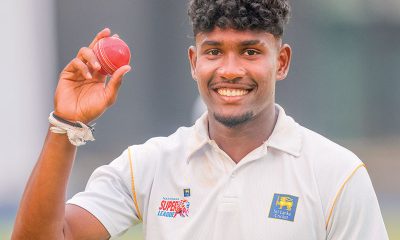
 Sports2 days ago
Sports2 days agoSri Lanka’s eternal search for the elusive all-rounder
-
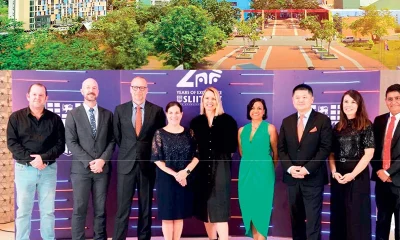
 Features6 days ago
Features6 days agoCelebrating 25 Years of Excellence: The Silver Jubilee of SLIIT – PART I
-

 Business6 days ago
Business6 days agoCEB calls for proposals to develop two 50MW wind farm facilities in Mullikulam
-
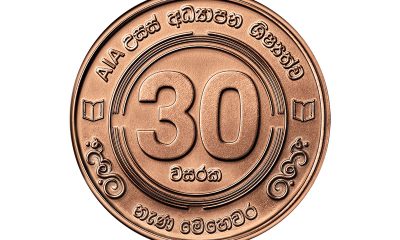
 Business4 days ago
Business4 days agoAIA Higher Education Scholarships Programme celebrating 30-year journey
-
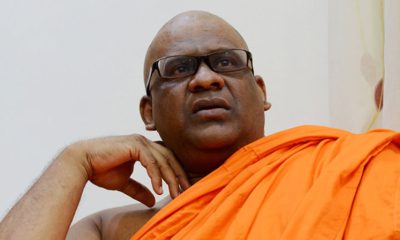
 News3 days ago
News3 days agoGnanasara Thera urged to reveal masterminds behind Easter Sunday terror attacks
-
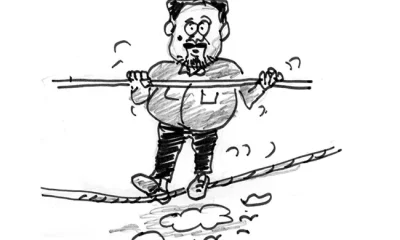
 Features6 days ago
Features6 days agoNotes from AKD’s Textbook
-
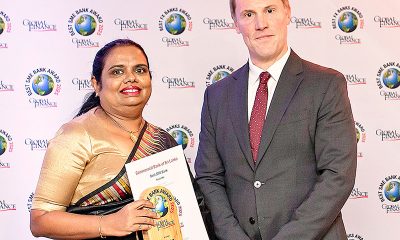
 News2 days ago
News2 days agoComBank crowned Global Finance Best SME Bank in Sri Lanka for 3rd successive year
-
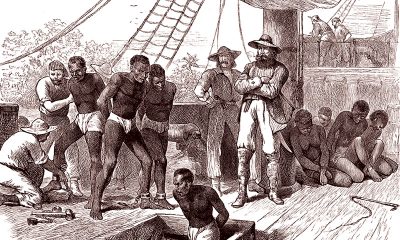
 Features2 days ago
Features2 days agoSanctions by The Unpunished











